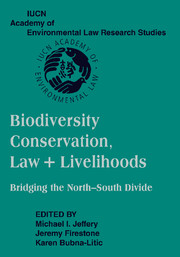 Biodiversity Conservation, Law and Livelihoods: Bridging the North-South Divide
Biodiversity Conservation, Law and Livelihoods: Bridging the North-South Divide Book contents
- Frontmatter
- Contents
- Acknowledgments
- Message from Kofi A. Annan, Secretary-General of the United Nations
- Macquarie Statement
- Contributors
- Introduction
- PART ONE THE CONTEXT
- PART TWO BIODIVERSITY: ITS CONSERVATION
- PART THREE CONSERVATION MEASURES
- PART FOUR USES OF COMPONENTS OF BIODIVERSITY
- 17 Legal Framework for the Ecological and Biodiversity Needs of Soil: Progress towards an International Instrument for the Sustainable Use of Soil
- 18 The Ghanaian Forestry Regime: Bridging the Gap between the North and the South
- 19 Bridging the Dominant-Indigenous Peoples Cultural Divide: Reflections on Makah Whaling
- PART FIVE PROCESSES AFFECTING BIODIVERSITY
- PART SIX BIOSECURITY ISSUES
- PART SEVEN ACCESS AND BENEFIT-SHARING
- Index
17 - Legal Framework for the Ecological and Biodiversity Needs of Soil: Progress towards an International Instrument for the Sustainable Use of Soil
Published online by Cambridge University Press: 31 July 2009
- Frontmatter
- Contents
- Acknowledgments
- Message from Kofi A. Annan, Secretary-General of the United Nations
- Macquarie Statement
- Contributors
- Introduction
- PART ONE THE CONTEXT
- PART TWO BIODIVERSITY: ITS CONSERVATION
- PART THREE CONSERVATION MEASURES
- PART FOUR USES OF COMPONENTS OF BIODIVERSITY
- 17 Legal Framework for the Ecological and Biodiversity Needs of Soil: Progress towards an International Instrument for the Sustainable Use of Soil
- 18 The Ghanaian Forestry Regime: Bridging the Gap between the North and the South
- 19 Bridging the Dominant-Indigenous Peoples Cultural Divide: Reflections on Makah Whaling
- PART FIVE PROCESSES AFFECTING BIODIVERSITY
- PART SIX BIOSECURITY ISSUES
- PART SEVEN ACCESS AND BENEFIT-SHARING
- Index
Summary
INTRODUCTION
It has been forecast that the global human population will increase from the present six billion to eight billion by the year 2020. In order for there to be sufficient food, both for these additional people and to raise the standard of provision for those at present with an inadequate diet, a large increase in food production must take place. This increase in food production must come from approximately the same land area as is at present under agriculture, as the remainder is too dry, too wet, too cold, or too steep and mountainous to make a significant contribution. This inevitably means greater pressure will be put on prime lands, and especially those with the most fertile soils, to provide the extra food required. As demand increases, there will be increasing pressure also on the less productive soils, where the impact of soil degradation is most dramatically seen, and this could possibly result in the displacement of people from their homelands.
The effects of the increase in the human population on the world, especially in terms of the decline in food security, indicates that soil has ecological limits that change according to the variations within different ecosystems and the cultural relationships with the land and soil resources. There is an increasing imbalance in the production of food because of the difference in the rate of deterioration of soils and their functions and the rate of their regeneration.
- Type
- Chapter
- Information
- Biodiversity Conservation, Law and Livelihoods: Bridging the North-South DivideIUCN Academy of Environmental Law Research Studies, pp. 329 - 346Publisher: Cambridge University PressPrint publication year: 2008
